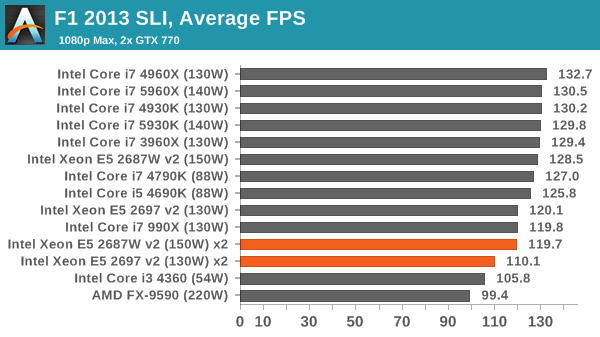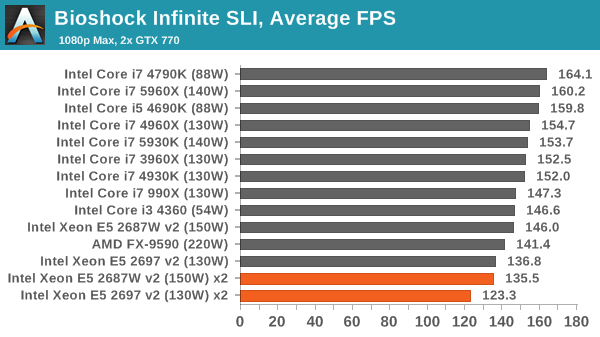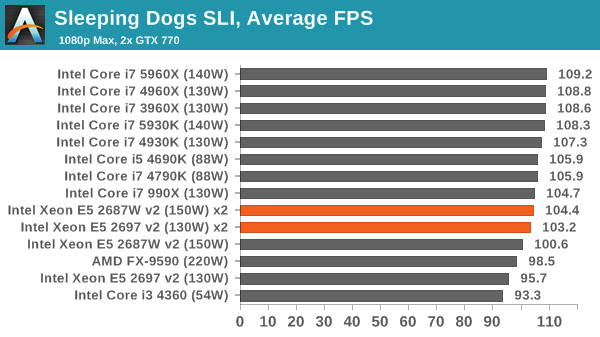GIGABYTE Server GA-7PESH3 Motherboard Review
by Ian Cutress on September 4, 2014 2:00 PM EST- Posted in
- Motherboards
- Intel
- Gigabyte
- Xeon
- Workstation
- Enterprise
- C602
Gaming Benchmarks
While gaming is not a focus of motherboards like the GIGABYTE GA-7PESH3, the system may be in use by content developers relying on an accurate representation with what they are making. GIGABYTE also includes a variety of multiple GPU connectors in the box, indicating that gaming is a use for this system. Gaming on 2P systems is usually restricted by the low single core speed of the processors used, or the memory mismanagement as games are not written to take advantage of a NUMA topology. In fact, our usual Tomb Raider benchmark failed to start at all, suggesting that a 2P system might be wholly engine dependent on what actually works or not. Games that are often heralded as using multiple cores are also usually stumped due to the dual processor nature of the system, causing cross CPU connections to add in extra latency and delays for data.
F1 2013
First up is F1 2013 by Codemasters. I am a big Formula 1 fan in my spare time, and nothing makes me happier than carving up the field in a Caterham, waving to the Red Bulls as I drive by (because I play on easy and take shortcuts). F1 2013 uses the EGO Engine, and like other Codemasters games ends up being very playable on old hardware quite easily. In order to beef up the benchmark a bit, we devised the following scenario for the benchmark mode: one lap of Spa-Francorchamps in the heavy wet, the benchmark follows Jenson Button in the McLaren who starts on the grid in 22nd place, with the field made up of 11 Williams cars, 5 Marussia and 5 Caterham in that order. This puts emphasis on the CPU to handle the AI in the wet, and allows for a good amount of overtaking during the automated benchmark. We test at 1920x1080 on Ultra graphical settings.

F1 2013 typically loves cores and frequency, however there is little gain here over an i3 except for 10-16 FPS in single GPU average frame rates.
Bioshock Infinite
Bioshock Infinite was Zero Punctuation’s Game of the Year for 2013, uses the Unreal Engine 3, and is designed to scale with both cores and graphical prowess. We test the benchmark using the Adrenaline benchmark tool and the Xtreme (1920x1080, Maximum) performance setting, noting down the average frame rates and the minimum frame rates.

Similarly Bioshock Infinite sees the 2P system at the bottom of the pack, especially in minimum frame rates.
Sleeping Dogs
Sleeping Dogs is a benchmarking wet dream – a highly complex benchmark that can bring the toughest setup and high resolutions down into single figures. Having an extreme SSAO setting can do that, but at the right settings Sleeping Dogs is highly playable and enjoyable. We run the basic benchmark program laid out in the Adrenaline benchmark tool, and the Xtreme (1920x1080, Maximum) performance setting, noting down the average frame rates and the minimum frame rates.

The only benchmark where the 2P shines is Sleeping Dogs in minimum frame rates under SLI. Here there is a distinct advantage of having dual processors over a single processor, moving well above 60 FPS minimum. However, the cost for those extra frames makes any other processor seem more palatable.
Battlefield 4
The EA/DICE series that has taken countless hours of my life away is back for another iteration, using the Frostbite 3 engine. AMD is also piling its resources into BF4 with the new Mantle API for developers, designed to cut the time required for the CPU to dispatch commands to the graphical sub-system. For our test we use the in-game benchmarking tools and record the frame time for the first ~70 seconds of the Tashgar single player mission, which is an on-rails generation of and rendering of objects and textures. We test at 1920x1080 at Ultra settings.

Finalising why gaming isn't great on a 2P machine: for Battlefield 4 the i3 scores similar or better than our 2P arrangement.
The end result of the story is: you can game on a dual processor workstation, but it won't be the best experience you can get.














35 Comments
View All Comments
tuxRoller - Thursday, September 4, 2014 - link
So, you've got a workstation class board but are running Windows 8...Is it so difficult to throw centos on there for the benefit of those working at Pixar?
MrSpadge - Friday, September 5, 2014 - link
Those working at Pixar likely won't need an Ivy-EP review. Apart from that.. I'm sure Ian is glad not to have to deal with CentOS :ptuxRoller - Friday, September 5, 2014 - link
Centos is easy to setup, and the new release is quite nice.My point with Pixar was that there are many serious creators who use Linux workstations, and not just for simulations. Unless you work in the area it's possible you may not know the prevalence of Linux among workstations, especially relative to windows 8, in my experience.
That aside, seeing the comparative performance numbers of the two OS's is useful to get an idea of what the hardware itself can do.
mpbrede - Friday, September 5, 2014 - link
I really hope that this crappy grammar is just an indication of haste and not of lower editorial standards now that Anand has left the room."As a result, gaming often sees a hit in performance, as well as basic tasks." -> ...result, gaming, as well as basic tasks, sees a hit...
"Interestingly GIGABYTE does not supply any extra power connectors for these PCIe slots, indicating that not each port might not be able to provide 75W when all are populated (e.g. seven graphics cards)." -> read it slowly, how many "nots" should there be in a single sentence?
aryonoco - Friday, September 5, 2014 - link
A server/workstation motherboard requires its own benchmarks.For anyone who is in the target market of this product, this review is absolutely worthless. Gaming benchmarks? Really?!
colonelclaw - Friday, September 5, 2014 - link
Thanks for the review. In the future please consider including the following benchmarks:3DSMax + Vray, Maya + VRay/Arnold/Renderman, Adobe Media Encoder, Adobe After Effects, Adobe Premiere Pro. Some VRay RT and Octane multi-GPU benchmarks would be a nice addition, too.
The one thing I find slightly strange about this motherboard is the low number of memory slots. All our DP motherboards have twice as many per processor (and many are full). I wonder why Gigabyte decided on just eight?
eanazag - Friday, September 5, 2014 - link
I think the point of making the board where the CPUs line up was to allow better airflow to the add-on cards (GPUs). Lining up the CPUs didn't allow for the normal # of mem. slots.In actuality I would think most buyers of this board would just go with one CPU. It allows for the video compute cards to have more juice from the ATX 24 pin. I have bought 2P boards for one proc because of the peripheral items like slots, networking, RAID, and built-in network management. When you look at non-server boards and add the pricing of add-on management it starts to make you consider the server/workstation board.
The Von Matrices - Friday, September 5, 2014 - link
The reason for this is because Gigabyte chose to use square ILM sockets.For those who do not know, LGA2011 has two sockets - square ILM and narrow ILM. Most consumer motherboards use the square ILM sockets; you only see the narrow ILM sockets in servers. The narrow ILM socket is obviously narrower, which allows more memory slots on the same size motherboard. The disadvantage of the narrow ILM socket is that the memory slots are so close to the processor that large and quiet tower heatsinks can't be used since they cover the closest memory slots.
Basically, when designing a dual LGA2011 SSI CEB motherboard, you have to choose two of the three following features:
16 DIMM slots
7 PCIe slots
Square ILM sockets
If you use 16 DIMMs and 7 PCIe slots, you have to use narrow ILM sockets, which eliminates the use of tower heatsinks.
If you use 7 PCIe slots and square ILM sockets (like Gigabyte did) you now can use tower heatsinks. However, then there is only enough space on the motherboard for 8 or 12 DIMM slots.
If you use 16 DIMMs and square ILM sockets, there's only enough space on the motherboard for 6 PCIe slots.
joannecdinkins - Friday, September 5, 2014 - link
just as Larry answered I didnt even know that people able to get paid $6104 in a few weeks on the internet .go to this site>>>>> paygazette.ℭOM
KAlmquist - Friday, September 5, 2014 - link
One thing that's not addressed in this review is whether it makes sense to run Windows 7 on a multi-socket system. The benchmarks showing dual E5-2687W processors running significantly slower than a single E5-2687W suggest that Windows 7 is making bad scheduling decisions. Would Windows Server or Linux do better?Let me explain my point about scheduling decisions in a bit more detail. If you run a piece of software on a system with a single processor, the operating system has to make decisions about when to run each thread, and which core to run it on. Now switch to a system which is similar to the first system except that it has two processors. If the operating system simply ignores the second processor, and makes the same scheduling decisions as it made on the first system, then the performance of the two systems should be quite close. I'm not suggesting that this approach to scheduling on a dual processors system makes sense, but it is a possible approach. So if the approach to scheduling used by Windows 7 results in even worse performance, we know that Windows 7 could do better. In fairness to Microsoft, Windows 7 is not marketed as a server OS, so maybe it shouldn't be expected to perform well on server hardware.